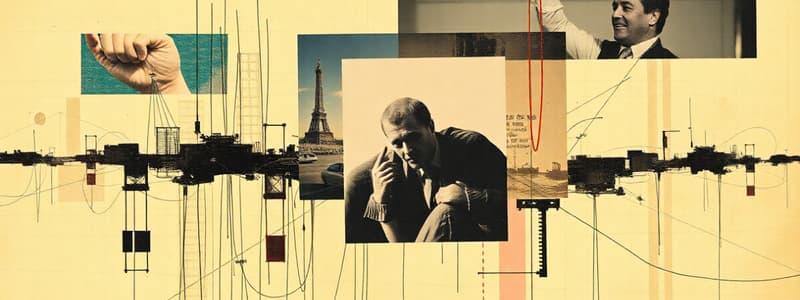Podcast
Questions and Answers
What is the main purpose of flow control in data communication?
What is the main purpose of flow control in data communication?
- To introduce additional errors for testing purposes
- To transmit data faster than the receiver can process it
- To ensure a fixed size of data packets
- To manage the rate of data transmission between sender and receiver (correct)
How does byte stuffing operate in data communication?
How does byte stuffing operate in data communication?
- By removing flags from the data stream
- By encoding the data into a three-byte sequence
- By adding an extra byte whenever five consecutive 1s are detected
- By inserting an extra byte when a flag or escape character is present (correct)
What triggers the need for flow control mechanisms?
What triggers the need for flow control mechanisms?
- The sender's capacity to send data rapidly
- The delays caused by network congestion
- The receiver's memory limit and processing speed (correct)
- The complexity of the data format being transmitted
In bit-oriented framing, what condition leads to bit stuffing?
In bit-oriented framing, what condition leads to bit stuffing?
What does error control in the data link layer primarily rely on?
What does error control in the data link layer primarily rely on?
What is the correct function of character-oriented framing?
What is the correct function of character-oriented framing?
Which statement correctly describes the sender-site algorithm of the simplest protocol?
Which statement correctly describes the sender-site algorithm of the simplest protocol?
What does bit stuffing help to prevent during data transmission?
What does bit stuffing help to prevent during data transmission?
What is the main action the sender takes in the Stop-and-Wait Protocol after sending a frame?
What is the main action the sender takes in the Stop-and-Wait Protocol after sending a frame?
What happens in Stop-and-Wait ARQ if the acknowledgment is lost?
What happens in Stop-and-Wait ARQ if the acknowledgment is lost?
In Go-Back-N ARQ, what happens if an acknowledgment for the first frame is not received?
In Go-Back-N ARQ, what happens if an acknowledgment for the first frame is not received?
What characteristic distinguishes Selective Repeat ARQ from other ARQ protocols?
What characteristic distinguishes Selective Repeat ARQ from other ARQ protocols?
How are frames numbered in the Stop-and-Wait Protocol and its variations?
How are frames numbered in the Stop-and-Wait Protocol and its variations?
In Go Back 3 with a scenario where every 5th packet is lost while sending 10 packets, how does this affect the total number of transmissions?
In Go Back 3 with a scenario where every 5th packet is lost while sending 10 packets, how does this affect the total number of transmissions?
Which protocol allows sending multiple frames before receiving the acknowledgment of the first frame?
Which protocol allows sending multiple frames before receiving the acknowledgment of the first frame?
What mechanism is used for error correction in Stop-and-Wait ARQ?
What mechanism is used for error correction in Stop-and-Wait ARQ?
Flashcards are hidden until you start studying
Study Notes
Data Link Layer Overview
- Character-oriented framing transmits data as sequences of bytes using 8-bit coding systems like ASCII.
- Bit-oriented framing sends data as sequences of bits suitable for interpreting text and multimedia at higher layers.
Framing Techniques
- Byte Stuffing: Adds one extra byte when a flag or escape character appears in the data to avoid misinterpretation.
- Bit Stuffing: Inserts an extra 0 after five consecutive 1s to prevent confusion with flag patterns like 0111110.
Flow Control Mechanism
- Flow control ensures data transmission pacing is matched between sender and receiver, preventing data overload.
- Procedures inform the sender of the receiver's capacity to manage incoming data and request reductions or pauses in transmission.
Error Control
- Relies on Automatic Repeat reQuest (ARQ) methods for data retransmission when errors are detected.
Simplest Protocol
- Demonstrates basic communication where the sender sends frames without awaiting receiver feedback.
- Involves sequential events for transmission at both sender and receiver sites.
Stop-and-Wait Protocol
- The sender transmits one frame and waits for an acknowledgment (ACK) before proceeding.
- If the ACK is not received within a specific timeframe, the sender retransmits the last frame, using sequence numbers based on modulo-2 arithmetic.
Sliding Window Protocol
- Facilitates sending multiple frames before receiving acknowledgments based on a defined window size.
- Enhances efficiency in data transmission by allowing overlapping of send and receive operations.
Go-Back-N ARQ
- Utilizes a sender's window size (N) to permit multiple frame transmissions prior to acknowledgment.
- Relies on sequential frame numbering, requiring retransmission of all frames in the window if an ACK is not received in time.
Selective Repeat ARQ
- Only retransmits damaged or lost frames upon receiving a negative acknowledgment (NACK) from the receiver.
- Ensures efficient handling of errors by acknowledging correctly received frames (ACK), minimizing unnecessary data retransmissions.
Example Scenario for Go Back 3
- In a network with every 5th packet lost while sending 10 packets:
- The sender will have to retransmit frames 1 to 3 repeatedly until the acknowledgment for frame 1 is received, implying a higher number of total transmissions.
Studying That Suits You
Use AI to generate personalized quizzes and flashcards to suit your learning preferences.




